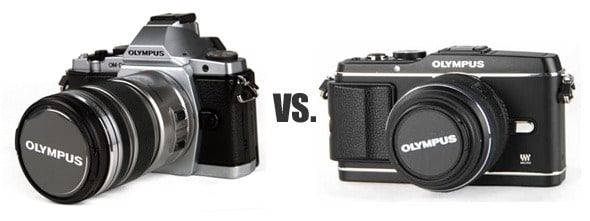Head to Head: Olympus OM-D E-M5 Vs. Olympus PEN E-P3
We've finished our review of the Olympus OM-D E-M5. See here how it stacks up against the Olympus PEN E-P3, our 2011 mirrorless camera of the year.
Products are chosen independently by our editors. Purchases made through our links may earn us a commission.
The Olympus PEN series of Micro Four Thirds cameras hit the scene a few years ago, bringing with them a retro design theme based around rangefinder cameras from the film era. The cameras have been a hit, combining a now-developed lens family, compact size, and solid design.
The Olympus OM-D E-M5 tries to repeat that feat, using the same lens family but calling on the design cues of the OM series of film SLRs that Olympus released in the 1970s. The OM-D E-M5 also sports a new 16-megapixel image sensor, high-speed shooting capabilities, and a built-in electronic viewfinder.

The PEN E-P3, the flagship of the current crop of PEN cameras, won our mirrorless camera of the year award for 2011 with a combination of intriguing style, solid handling, and excellent color accuracy.
Being from the same manufacturer, the two cameras are quite similar, though there are some key differences you should keep in mind when selecting between them. They both share a touchscreen OLED rear monitor, incredibly fast contrast-based autofocus, and the same unorganized menu system.
{{brightcove '1645732913001'}}
In shooting with the two cameras, the overall experience is quite pleasant, even if the menu system can get a bit frustrating to navigate. Both cameras handle well, though they feature rigid grips rather than the plush rubberized material you might expect on other cameras.
The OM-D E-M5 has the benefit of being weather sealed (as long as the lens you're using is also sealed) and has the built-in electronic viewfinder, which comes in handy in tough lighting. The E-P3 is smaller, has sharper images with its kit lens, and has a nifty interchangeable grip that lets you slightly customize handling on the camera.
In terms of image quality, the 12.3-megapixel E-P3 has more accurate colors, sharper images with hte kit lens, but seriously falls down past ISO 800 due to an older generation of image sensor. The 16-megapixel sensor in the E-M5 is much better prepared to handle high ISO shooting with greater dynamic range, but we found that it offered slightly less accurate colors in general.
Altogether, it's a very close call. In our standard scoring setup, the E-P3 just ekes out a few extra points over the E-M5. If you want a compact camera with great image quality but aren't as concerned with low light shooting, go for the E-P3. If you need the extra low light ability, dynamic range, and weather sealing then the E-M5 is the better option between the two. Either way you're getting a well-designed camera that handles well, focuses very quickly, and can capture high quality images in the right conditions.
